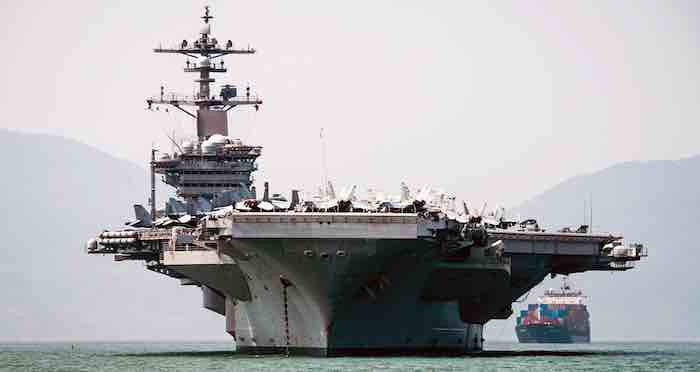China's aggressive, bullying tactics in the South China Sea
Countering China’s Blue Water Navy

Based on China’s massive military expansion over the last two decades, particularly the People’s Liberation Army’s (PLA) Navy, their goal is clearly to challenge the U.S. Navy’s dominance, not only in the Western Pacific, but globally. In a recent hearing before the House Permanent Select Committee on Intelligence on 17 May 2018, that was clearly pointed out by two experts on the Chinese threat, Rick Fisher and Captain James Fanell, USN (ret). They explained how the Chinese Navy dramatically expanded from a coastal force to a global threat, capable of challenging the U.S. Navy’s dominant position in the Western Pacific today, and globally in the next decade.
China's aggressive, bullying tactics in the South China Sea
This new reality is particularly challenging, with the serious decline in our overall military capability and readiness, as a result of the Obama administration’s disastrous sequestration mandate. As a result we now have the smallest Navy since prior to World War I. Nowhere is the Chinese challenge more serious than in the Western Pacific, particularly in the South China Sea. Hegemony over the South China Sea is essential for China to achieve its goal of conquering the free and democratic island of Taiwan. However, the South China Sea is an international strategic waterway through which over $5 trillion worth of commerce transits on an annual basis. The South China Sea remaining free from the threats of China’s Communist regime is critical for not only world commerce but also for our allies Japan, South Korea, the Philippines and certainly Taiwan.
China has continued its aggressive and bullying tactics by creating several artificial islands on contested rocks and shoals in the South China Sea. They have built an air and naval base on Woody Island in the Paracel Group, and also have built new large naval, air, and missile bases on Fiery Cross Reef, Subic Reef, and Mischief Reef. There are now three completed runways of approximately 10,000 feet that can accommodate about 24 aircrafts each. As Rick Fisher pointed out to the Committee, reports in May 2018 indicate that China has now deployed 400-Km range YJ-12 supersonic anti-ship missiles as well as 200-Km range HQ-9B fourth generation surface-to-air missile (SAMs), which would allow the PLA to deny access to most military aircraft as well as commercial airlines and shipping traffic. These man-made islands, in effect, are stationary aircraft carriers. The good news is that since they can’t move, they are vulnerable.
The islands were militarized in spite of a declaration by China’s President Xi Jinping on 25 September 2015, at the White House, saying that that he would not militarize these islands. The double talking should not come as a surprise. As a result, China has been uninvited to participate in this year’s bi-annual RIMPAC multinational naval exercise in the Pacific. They never should have been invited in the first place as it was a form of “appeasement!”
As Fisher pointed out, having built this series of extended bases in the Spratly Island region with no serious opposition, China can plan much greater island-building efforts for the future. Make no mistake, China’s goal is to exercise hegemony over the First Island chain, which includes Taiwan, and eventually, out to the Second Island chain which includes Guam, our key Western Pacific base. Should China be successful in defeating Taiwan, it would be a great strategic win as it would provide greater access for China’s nuclear ballistic submarine fleet to the Pacific open waters.
China’s “Belt and Road” initiative in the Indian Ocean
Likewise, China’s “Belt and Road” initiative in the Indian Ocean, under the guise of developing commercial ports, is providing cover for the development and use of facilities by the Chinese Navy in Sri Lanka and Pakistan. China has also reached into Latin America by attempting to reignite the Falklands War. Fortunately, with a change in the Argentine government that initiative has failed.
The Trump administration’s task, in confronting the Chinese totalitarian threat, is similar to what President Reagan faced in confronting an aggressive Soviet Union in 1981. President Trump has taken a page out of the Reagan playbook by embarking on an aggressive Navy ship building program, but regretfully it is only planned to build the Navy back to 355 ships. To meet our worldwide commitments and raise the deterrence equation, the Navy needs 400 ships. With our reduced domestic shipbuilding capacity it would take more than two decades to achieve that goal. Regretfully, time is not on our side. China will be ready to move more aggressively by 2025. Therefore, to achieve the desired number of ships, we need to think outside the box. We should consider contracting with our allies for constructing ship hulls or more complete frigate-size ships. We also need to reactivate ships from the Navy’s Reserve Fleet and update them with modern equipment. It’s called the Fleet Rehabilitation and Modernization (FRAM) program.
We also need new strategic thinking with our allies in the Western Pacific to counter the rising Chinese threat. The Trump administration has made a move in that direction by calling for Australia, Japan, India, and the U.S. to form a “Quad.” This is a step in the right direction, but it needs to be expanded into a Pacific-type NATO organization which should include all our allies including India. Taiwan should initially be made an associate member. In that regard, Taiwan needs to be equipped with sufficient defense equipment by no later than 2020 to provide a capability to prevent any successful invasion by China. A preplanning staff needs to be established on Guam as soon as possible with all member countries participating. We must quickly raise the deterrence equation by not only increasing our force levels, but also by developing aggressive exercises in contested areas. Time is of the essence.
James A. Lyons, Jr. Admiral, USN (ret) -- Bio and
Archives |
Comments
James A. Lyons, a retired U.S. Navy admiral, was commander in chief of the U.S. Pacific Fleet and senior U.S. military representative to the United Nations.

 Based on China’s massive military expansion over the last two decades, particularly the People’s Liberation Army’s (PLA) Navy, their goal is clearly to challenge the U.S. Navy’s dominance, not only in the Western Pacific, but globally. In a recent hearing before the House Permanent Select Committee on Intelligence on 17 May 2018, that was clearly pointed out by two experts on the Chinese threat, Rick Fisher and Captain James Fanell, USN (ret). They explained how the Chinese Navy dramatically expanded from a coastal force to a global threat, capable of challenging the U.S. Navy’s dominant position in the Western Pacific today, and globally in the next decade.
Based on China’s massive military expansion over the last two decades, particularly the People’s Liberation Army’s (PLA) Navy, their goal is clearly to challenge the U.S. Navy’s dominance, not only in the Western Pacific, but globally. In a recent hearing before the House Permanent Select Committee on Intelligence on 17 May 2018, that was clearly pointed out by two experts on the Chinese threat, Rick Fisher and Captain James Fanell, USN (ret). They explained how the Chinese Navy dramatically expanded from a coastal force to a global threat, capable of challenging the U.S. Navy’s dominant position in the Western Pacific today, and globally in the next decade.